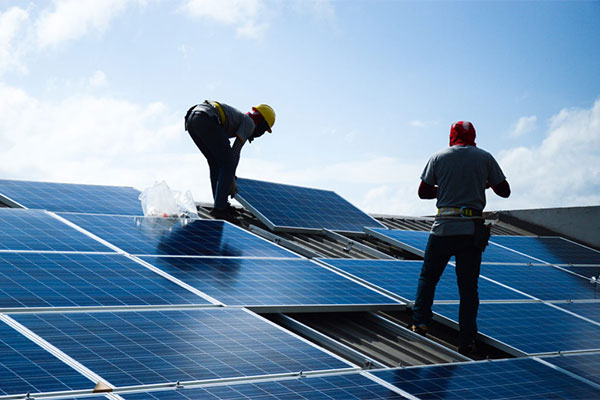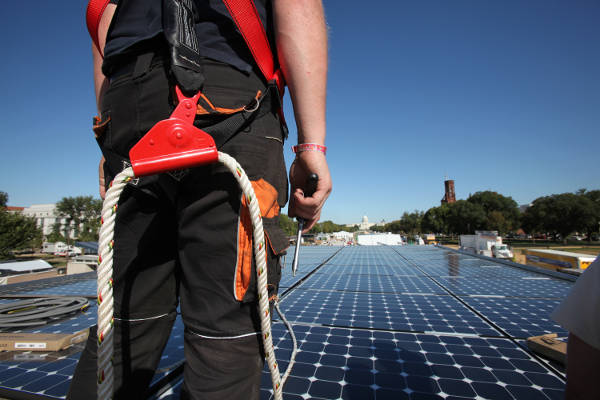- In November, solar energy reached a historic milestone, setting a new monthly record for capacity additions in the U.S. energy sector.
- This surge places solar at the forefront of U.S. energy generation, outpacing other traditional and renewable sources.
- With its rapid growth, solar is expected to soon surpass hydro, nuclear, wind, and coal in individual capacities.
Washington DC – A review by the SUN DAY Campaign of data newly-released by the Federal Energy Regulatory Commission (FERC) reveals that solar significantly outpaced all other energy sources in new U.S. generating capacity added in November as well as during the first eleven months of 2023.
In its latest monthly “Energy Infrastructure Update” report (with data through November 30, 2023), FERC says solar provided 13,169 megawatts (MW) of new domestic generating capacity to date in 2023 or 46.5% of the total. That is more than any other energy source and nearly equal to the combined new capacity from natural gas (9,205-MW) and wind (4,424-MW). Moreover, solar capacity additions during the first eleven months of this year were 43.1% greater than for the same period last year.
Capacity additions by solar in November set a new monthly record – 1,982-MW – and accounted for 73.7% of new capacity placed into service. Most of the balance came from wind (677-MW) with very small contributions by natural gas (15-MW), oil (8-MW), geothermal (4-MW), and biomass (3-MW). The mix of renewables thus provided 99.1% of capacity additions for the month. Year-to-date, renewables have provided nearly two-thirds (63.3%) of all new generating capacity, trailed by natural gas (32.5%) and nuclear power (3.9%).
The latest capacity additions have brought solar’s share of total available installed generating capacity up to 7.5%. Wind is currently at 11.7% and hydropower at 7.9%. With the inclusion of biomass (1.2%) and geothermal (0.3%), renewables now claim a 28.6% share of total U.S. utility-scale generating capacity.
For perspective, at the beginning of 2023, solar’s share was 6.4% while wind and hydropower were 11.4% and 8.0% respectively. The mix of all renewables totaled 27.3%. [1]
If the growth trends of 2023 continue, installed utility-scale solar capacity should exceed that of hydropower within the next several months and that of nuclear power (8.1%) in less than a year’s time. Solar capacity is also likely to exceed the individual capacities of both wind and coal in the near future. [2]
FERC reports that “high probability” additions of solar between December 2023 and November 2026 total 91,152-MW – an amount more than four and one-half times greater than the forecast net “high probability” net additions for wind (19,291-MW) and nearly 25 times more than those projected for natural gas (3,670-MW). FERC also foresees just 543-MW of hydropower growth while coal is projected to contract by 17,733-MW.
And the numbers for solar may prove to be conservative. FERC reports that there may actually be as much as 216,466-MW of new solar additions in the three-year pipeline. Moreover, FERC’s three-year forecast for just “high probability” solar increases with each new monthly “Infrastructure” report.
If just the current “high probability” additions materialize, by late autumn 2026, solar will account for almost one-seventh (13.6%) of the nation’s installed generating capacity. That would be more than wind (12.3%) and substantially more than either hydropower or nuclear power (both 7.4%).
In addition, solar’s share of utility-scale generating capacity would nearly equal that of coal (13.9%).
But it should be noted that FERC only reports data for utility-scale facilities (i.e., those rated 1-MW or greater) and therefore its data do not reflect the capacity of distributed renewables, notably rooftop solar PV. According to the U.S. Energy Information Administration (EIA), small-scale solar PV is estimated to accounted for 30.7% of the nation’s electrical generation by solar during the first ten months of 2023. [3]
That suggests that the total of distributed and utility-scale solar capacity combined is significantly more than the 7.5% FERC reported as solar’s share of total capacity at the end of November. It is perhaps closer to 10.0% and on track to approach 18.0% or more within three years thereby significantly surpassing that of coal. It would also bring the generating capacity provided by the mix of all renewables close to that of natural gas.
In three years, natural gas would still comprise the largest share of installed generating capacity (41.4%). However, solar would be in second place while the mix of all renewable sources (i.e., solar plus wind, hydropower, geothermal, and biomass) would total 34.7% of utility-scale capacity and possibly 39.0% of all generating capacity if smaller-scale solar is included.
“Solar is proving to be a giant killer,” noted the SUN DAY Campaign’s executive director Ken Bossong. “Within two or three years, it will be the largest renewable energy source by capacity and second only to natural gas among all energy sources.”













Comments